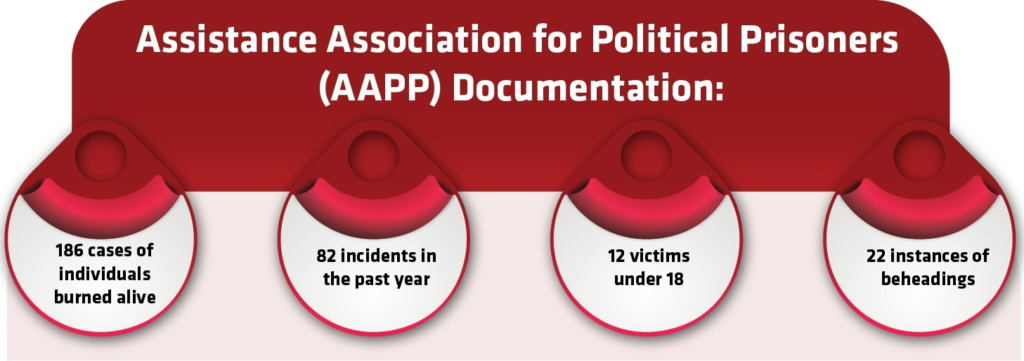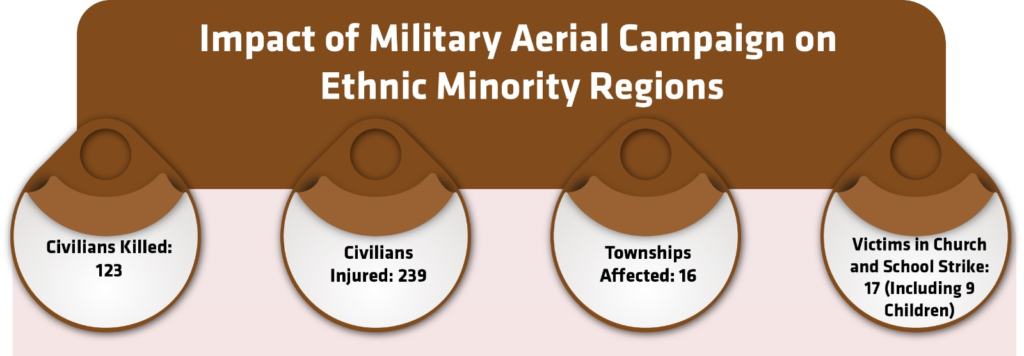Key Highlights:
- The brutal crackdown by the Myanmar junta has led to the tragic loss of at least 4,962 civilians since the coup on February 1, 2021
- On November 7, 2023, a horrific incident unfolded in Myauk Khin Yan, northern Myanmar, where 2 individuals were hung from a tree and set on fire by a pro-junta militia
- In southeastern Kayah state, also known as Karenni, approximately 80% of the population has experienced displacement
The brutal crackdown by the Myanmar junta has led to the tragic loss of at least 4,962 civilians since the coup on February 1, 2021, as reported by the Assistance Association for Political Prisoners (AAPP). In April alone, 121 civilians, including 16 children, fell victim to this violence. Additionally, the association has documented around 1,750 more civilian deaths awaiting verification.
One particularly heinous event occurred on April 22nd, when junta forces shelled the village of Pyin Taw Oo, resulting in the deaths of 3 children and an elderly man. Adding to this tragedy, 2 more residents lost their lives when mourners returning from the victims’ funerals were targeted by the regime’s forces.
According to the AAPP, between January and April, junta attacks claimed the lives of 223 females, including 40 girls under 18. Among these casualties, 98 women died due to shelling, while airstrikes accounted for 82 deaths. Sagaing Region witnessed the highest number of female fatalities, with 70, followed by Rakhine State with 53.
You can also read: From Vietnam to Gaza: US Campuses Reignite as Hubs of Anti-War Dissent!
Furthermore, the rights group reported that at least 75 females, including a six-year-old girl, were detained in April and remain incarcerated. Regime courts have imposed lengthy prison sentences on 27 females under the Counterterrorism Law, including 7 receiving life imprisonment.
In another egregious violation of international law, the junta’s forces bombed Wun Ma Thuu Hospital in Chin State, resulting in the deaths of 4 patients and a medical worker, with approximately 15 others injured. This attack marks one of 35 hospitals and clinics targeted by the junta since February.
The violence perpetrated by the Junta has also forced thousands of Rohingyas to seek refuge in Bangladesh, precipitating a global humanitarian crisis.
Pro-Junta Militia’s Reign of Fear in Northern Myanmar
On November 7, 2023, a horrific incident unfolded in Myauk Khin Yan, northern Myanmar, where 2 individuals were hung from a tree and set on fire by a pro-junta militia. In March 2022, another grim incident occurred when a villager was cruelly chained to a vehicle and dragged to his death.
The village has since become a stronghold for the militia following the coup, leading to the displacement of hundreds of residents. This exodus has only escalated since the burning incident. Among those fleeing, Phoe Ei Thu, aged 17, tragically lost her leg to a landmine while escaping from Myauk Khin Yan in early January.
Since the coup, the AAPP has meticulously documented 186 cases of individuals being burned alive by the military or its affiliated militia, with 82 incidents occurring last year alone, including 12 victims under the age of 18. Shockingly, the youngest victim was only 5 years old, as reported by the AAPP. Additionally, the group has recorded 22 instances of beheadings and continues to verify further reports of violence.
Myanmar Witness, a project by the non-profit Centre for Information Resilience dedicated to gathering evidence of military atrocities, has received over 400 reports detailing the burning of bodies, either before or after execution.
Myauk Khin Yan: A Grim Chronicle

Ethnic Communities Bear Brunt of Military’s Aerial Offensive
Terror descends from the skies as the military initiates a massive aerial bombing campaign in regions inhabited by ethnic minorities or exhibiting anti-coup resistance. Analysts and human rights organizations assert that the military’s indiscriminate use of airstrikes and artillery deliberately targets civilian infrastructure, with motives beyond mere territorial reclamation.
Rather, their objective appears aimed at displacing populations, expelling communities, and perpetuating chaos in areas under resistance control. In southeastern Kayah state, also known as Karenni, approximately 80% of the population has experienced displacement.
The Ta’ang Women’s Organization reveals that since the commencement of Operation 1027 on October 27, 123 civilians have lost their lives, and 239 others have suffered injuries due to airstrikes, shelling, and landmines across 16 northern Shan State townships. Notably, an airstrike struck a village church and a school, claiming the lives of 17 individuals, including 9 children.

Rohingya Nightmare: Junta Atrocities Spark Exodus
The Junta army has perpetrated numerous human rights abuses against the Rohingya people. In 2017, they launched a brutal clearance operation resulting in the killing and raping of thousands and the burning of their villages.
This sparked a mass exodus of around 700,000 Rohingyas fleeing to neighboring Bangladesh. These refugees joined around 300,000 people already in Bangladesh from previous waves of displacement, effectively forming the world’s largest refugee camp.
Bangladesh, hosting the majority of Rohingya refugees, grapples with strained infrastructure and limited resources. Refugees lack access to basic services, education, food, clean water, and sanitation, raising concerns about disease outbreaks, malnutrition, and exploitation. The crisis has garnered global attention numerous times, prompting calls from the UN for comprehensive, durable, and inclusive solutions.
Myanmar’s Resilient Masses Undeterred by Junta’s Violence
Senior Gen. Min Aung Hlaing, leader of the junta, has remained silent on the widespread reports of civilian abuse by his military, neither condemning nor acknowledging them. However, there are indications that the military’s strategy of using heavy weaponry alongside brutality is proving ineffective. With stretched resources and the high cost of maintaining airpower, the junta faces challenges.
To address manpower shortages due to losses and defections, the junta recently enacted a mandatory conscription law for all young individuals. This move spurred a surge in young people seeking visas to leave the country or joining resistance groups.
While international sanctions play a crucial role, greater action from the global community is necessary to sever the junta’s access to jet fuel and international currency and to halt the flow of arms to the regime. Rather than weakening the resolve of the populace, the junta’s extreme violence has only strengthened Myanmar’s people’s determination to remove the military from power.
The harrowing accounts of brutality and violence perpetrated by the Myanmar junta paint a grim picture of the ongoing crisis since the coup in February 2021. With nearly 5,000 civilians tragically lost to junta attacks, and countless more displaced, injured, or detained, the toll on Myanmar’s population is immeasurable. As the international community grapples with how to respond effectively, one haunting question remains: How much longer can the junta continue its reign of terror before meaningful intervention brings an end to the suffering of Myanmar’s people?


